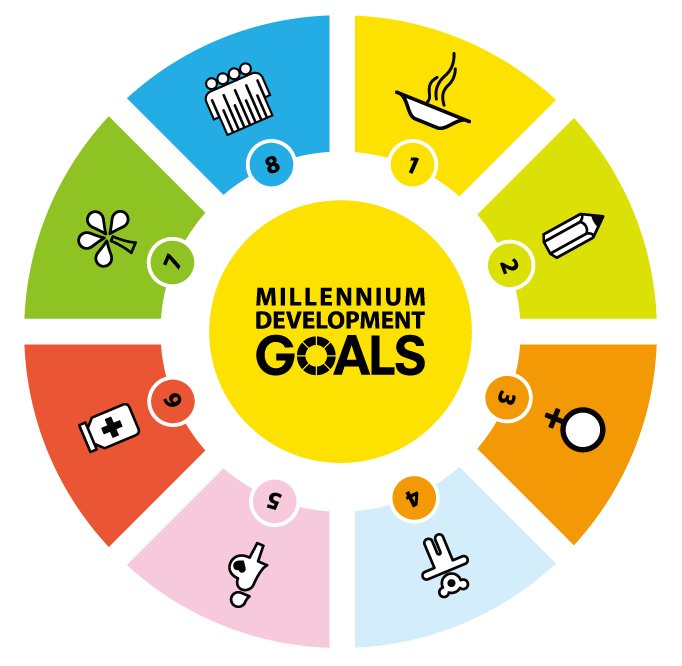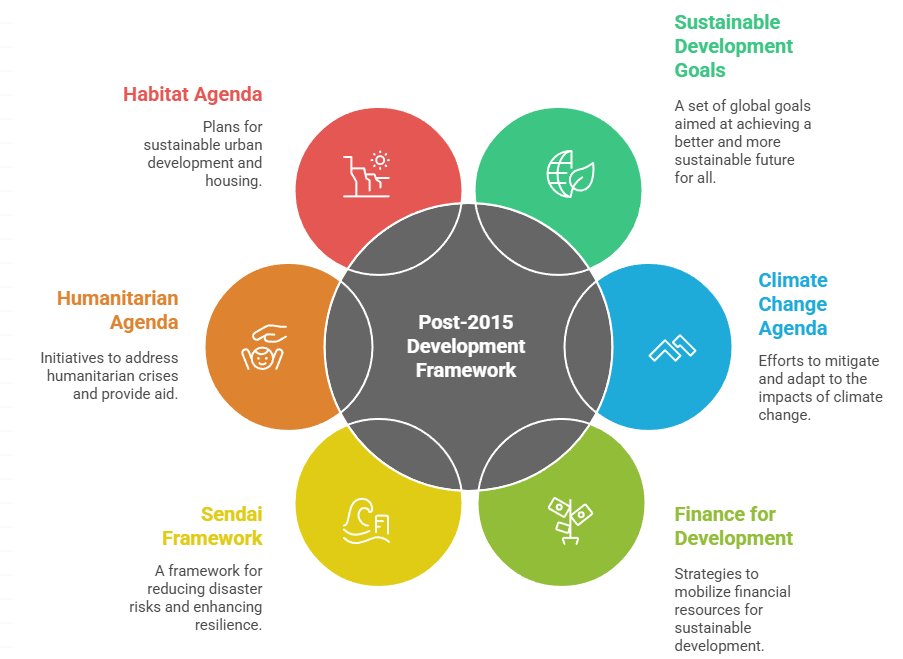
Sustainable Development Goals and Beyond ...
This section provides a framework for understanding the Post 2015 Development Agendas.
When the Millennium Development Goals (MDGs) ended in 2015, the international community came together once again, under the auspices of the United Nations, to formulate a development agenda for adoption beyond 2015.
These six agendas (which go beyond just the SDGs) together became known as the "Post-2015 Agendas"
Objectives of the NGO Café's Post-2015 Framework:
- Raise Awareness of the Interconnected Global Agendas:
To inform NGOs, civil society actors, and the general public about the six key Post-2015 Development Agendas and their complementary roles in promoting sustainable, inclusive, and resilient development.- Promote Policy Coherence and Integrated Action:
To highlight the importance of viewing the Post-2015 agendas as an integrated framework, encouraging coordinated efforts, cross-sector collaboration, and shared learning among development stakeholders.- Encourage Practical Engagement and Localized Implementation:
To showcase tools, strategies, and good practices (such as the GDRCfs GET Matrix) that NGOs and other actors can use to align their work with these global agendas and catalyze real change at the local, national, and global levels.
The Post-2015 Development Agendas:
A Comprehensive Framework for Global Action
|
Abstract: The Post-2015 Development Agendas emerged as a comprehensive and integrated response to the limitations and lessons of the Millennium Development Goals (MDGs), recognizing the need for a broader, interconnected framework to address global challenges. Comprising six key agendas - the 2030 Agenda for Sustainable Development, the Paris Agreement, the Sendai Framework, the New Urban Agenda, the Addis Ababa Action Agenda, and the Agenda for Humanity - this collective framework emphasizes the interconnectedness, complementarity, and coherence of sustainable development efforts. Despite uneven progress across the agendas, they offer a powerful blueprint for transformative change, grounded in multilateral cooperation, inclusive partnerships, and systemic solutions. Tools such as the GDRC's GET Matrix (Governance-Education-Technology) provide practical mechanisms for cross-sectoral integration and decision-making, reinforcing the need for strong political will and coordinated implementation to realize the goals of sustainable, resilient, and inclusive development.
Keywords: |
| Hari Srinivas | |
| Post-2015 Series E-219 |
UNmember states decided to adopt the Millennium Development Goals (MDGs) in response to the urgent need for a unified global strategy to tackle widespread poverty, inequality, and underdevelopment. By the late 1990s, despite decades of development aid and programs, many countries still faced severe challenges such as extreme poverty, high child mortality, lack of education, and preventable diseases.
The MDGs, launched at the UN Millennium Summit in 2000, were seen as a way to focus international attention, set clear and measurable targets, and foster accountability among governments, donors, and development agencies. The goals aimed to create a shared global vision and a coordinated effort to improve human well-being and promote sustainable development.
 |
 |
 |
Figure 1: Evolution from the MDGs to the SDGs
The MDGs helped mobilize global efforts and resources, resulting in significant progress in many areas, though achievements varied across regions and countries. When the Millennium Development Goals (MDGs) ended in 2015, albeit with uneven achievement across goals and countries, the international community came together once again, under the auspices of the United Nations, to formulate a development agenda for adoption beyond 2015. These agendas (which go beyond the SDGs themselves) became known as the "Post-2015 Agendas"
The Post-2015 Development Agendas represent a collective global commitment to address critical challenges across sustainability, resilience, disaster risk, climate change, urbanization, and financing for development. Viewed together, these six agendas form an integrated framework that guides coordinated action at local, national, and global levels, reinforcing the need for inclusive partnerships, transformative governance, and sustainable solutions.
Viewing the six Post-2015 Development Agendas collectively is highly useful because they are interconnected, complementary, and together offer a comprehensive and coherent framework for achieving sustainable, resilient, and inclusive global development. Integrated action across these agendas maximizes efficiency, strengthens solidarity, and accelerates progress toward shared goals.
- Interconnectedness: The six Post-2015 agendas (2030 Agenda for Sustainable Development, Paris Agreement, Sendai Framework, New Urban Agenda, Addis Ababa Action Agenda, and Agenda for Humanity) are deeply interconnected. Each one addresses a different dimension of sustainable development, but they overlap heavily in goals, mechanisms, and required actions, as well as responsible stakeholders.
- Complementarity: The six agendas reinforce each other. For example, achieving SDGs (2030 Agenda) depends on climate action (Paris Agreement), resilient infrastructure (Sendai Framework), sustainable cities (New Urban Agenda), financing (Addis Ababa Action Agenda), and humanitarian support (Agenda for Humanity).
- Comprehensive View: Taken together, they provide a full spectrum approach to sustainable development - prevention, response, mitigation, adaptation, financing, and governance are all covered. No single agenda alone is enough.
- Policy Coherence: Looking at them collectively promotes coherence across policies, funding, and implementation mechanisms at local, national, and global levels. It helps avoid duplication and conflicting efforts.
- Operational Efficiency: For governments, institutions, and stakeholders, working from a collective frame allows integrated planning, monitoring, and reporting, leading to better use of resources and greater impact.
- Global Solidarity: Collectively, they embody the spirit of multilateralism and shared responsibility, especially important in an era of global crises like climate change, pandemics, and conflicts.
| Agenda | Current Status | Key Issues |
|---|---|---|
| Sustainable Development Goals (SDGs) | Largely off track (only about 15% of targets on track) | Rising poverty, inequalities, slow progress on education, health, and environment |
| Climate Change Agenda | Far behind Paris Agreement goals | Emissions rising, adaptation and mitigation efforts insufficient |
| Finance for Development | Financing gaps widening | Debt burdens growing, investment in sustainable development too low |
| Sendai Framework for Disaster Risk Reduction | Risk reduction not keeping pace with rising risks | Underinvestment in resilience, increasing disaster losses |
| Humanitarian Agenda | Humanitarian needs at record highs | Conflict, climate shocks, funding shortfalls |
| Habitat Agenda (Urban Development) | Progress uneven and slow | Slum growth, urban inequality, inadequate infrastructure and services |
But a Word of Positivity
Despite the slow progress in achieving the Post-2015 agenda, there is still strong potential for transformative change. Frameworks like GDRC's GET Matrix, which integrates governance, education, and technology across all sectors and levels, show that practical solutions already exist. What is urgently needed is the collective will to implement these solutions boldly and consistently. However, realizing the potential of these solutions requires strong political will, effective policy coordination, and the commitment to leverage existing tools and technologies. With a concerted effort, it is possible to drive systemic change and achieve the sustainable development objectives outlined in these global agendas.
